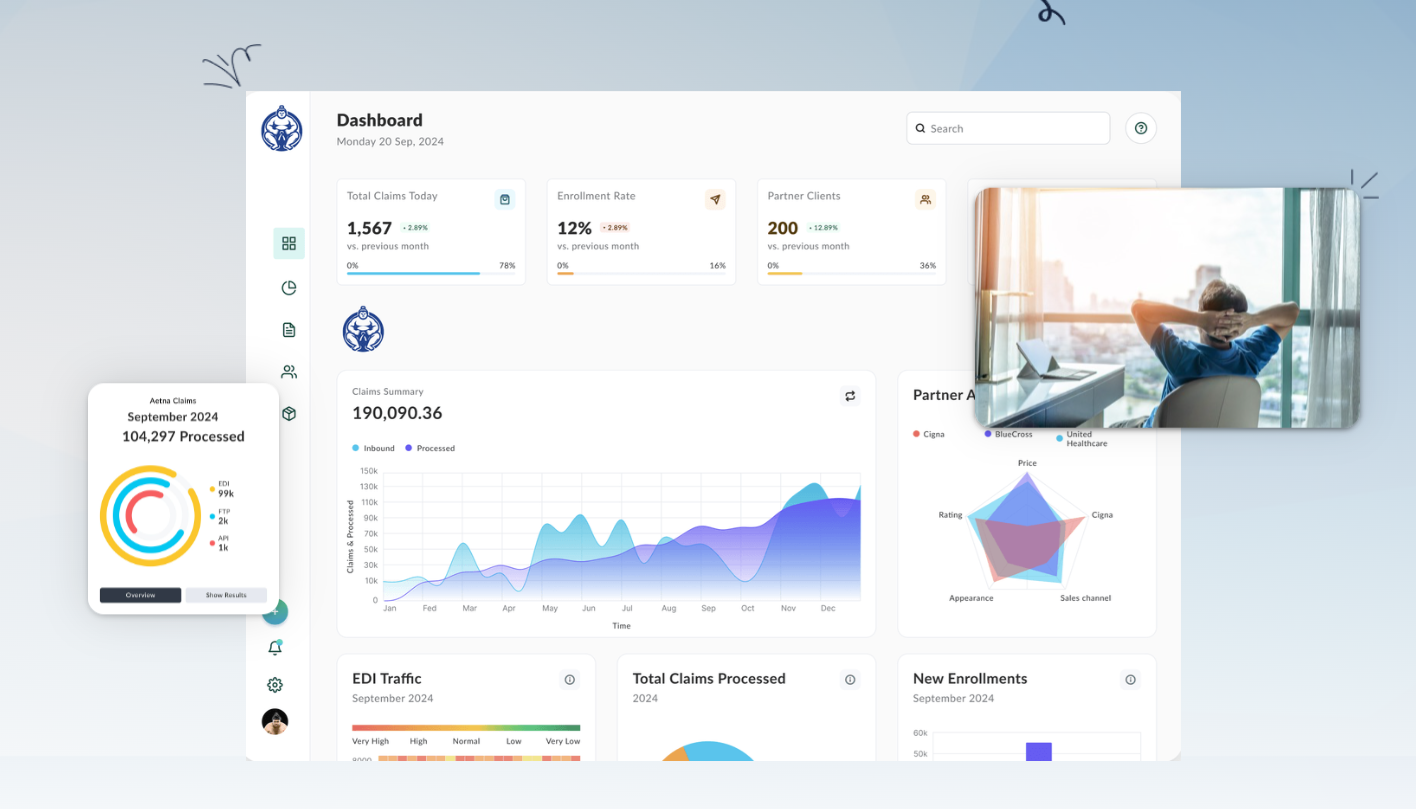Turning EDI Transaction Data Into Actionable Insights: A Strategic Guide for Health Insurance Payers


Health insurance payers are awash in data, yet truly actionable insights often remain out of reach. Every day, thousands or millions of EDI transactions—enrollments, eligibility checks, claims submissions, remittances—stream into payer systems in EDI 834, 837, 277, 999, and other industry-standard and custom formats. The potential is enormous: buried in this flow of structured data are patterns that can reveal operational bottlenecks, compliance risks, service gaps, and significant opportunities for efficiency. But as we've seen time and again, converting raw EDI data into insights that drive real business action is a much bigger challenge than it appears.

Why Actionable Insights from EDI Data Are Essential
EDI was designed for fast, standardized data exchange—not for rich business intelligence. However, in today's healthcare payer landscape, actionable EDI insights are no longer a nice-to-have. They're central to:
- Meeting tight SLAs for claims and eligibility
- Responding to member and provider inquiries with speed and accuracy
- Identifying and correcting errors before they create compliance issues
- Optimizing operational efficiency and reducing unnecessary costs
- Empowering support staffs to resolve problems at the point of contact without deep IT involvement
The Challenge: EDI Data is Siloed, Messy, and Opaque
Payers know this story all too well: EDI data arrives in multiple formats and structures—some files are standard X12, others arrive as CSV, Excel, XML, or custom positional layouts. Each must be validated, mapped, and loaded. Then, these files typically land in isolated transactional systems: the eligibility platform, the claims processing stack, the enrollment admin, and perhaps a data warehouse that's a week behind.
This fragmented reality makes it difficult for business users to:
- Trace a member's claim journey in real time
- Spot recurring file errors before they're felt downstream
- Surface trends in claims delays, enrollment spikes, or eligibility terminations
- Access the full audit trail when a regulatory audit looms
Too often, support teams end up dependent on IT to pull data, chase down discrepancies, or debug issues with trading partners, which leads to lost productivity and missed opportunities.
Turning Transaction Data Into Action: A Strategic Approach
At EDI Sumo, we believe actionable EDI insight requires a blend of standardization, real-time visibility, and frontline empowerment. Let's dig into the core steps to transform transactional data flow into strategic business advantage for health insurance payers:
1. Standardize EDI Data Across Formats
The journey starts by eliminating manual file translation and mapping headaches. Whether it's a classic EDI 834 enrollment, a 837 claim, a positional file from a small trading partner, or a last-minute Excel update, all must be normalized to a common, queryable data set.
- Remove format variability: Map and validate data from CSV, XML, X12, and more, bringing everything into a single structure.
- Apply robust validation: Ensure not just structural, but business rule accuracy before loading into downstream systems.
This unified approach frees payers from the limitations of their source files and puts all transaction data onto a level playing field, ready for analysis and integration.

2. Enable Real-time Monitoring & Error Alerts
Timeliness is critical in insurance operations. True insight only emerges when stakeholders have up-to-the-minute visibility into file status, errors, and exceptions:
- Real-time dashboards let teams see which files are flowing, which are delayed, and why—without needing database queries or IT tickets.
- Automated alerts and notifications flag issues (incorrect member IDs, date mismatches, missing segments) so errors can be remediated before triggering downstream problems or compliance penalties.
- Granular file tracking assures you know exactly when a claim or enrollment was received, validated, and processed, supporting audit readiness and SLA guarantees.
This proactive exception management heads off rework, reduces cycle time, and empowers not just IT, but every operational team.
3. Put Data in the Hands of End Users
Payers often rely on technical teams to extract data or run ad hoc reports. That creates bottlenecks and limits the organization's agility. The real transformation happens when:
- Customer service reps can instantly search member, eligibility, or claims detail—including historical transactions—responding on the first call.
- Operational managers access performance dashboards tracking lag time, error rates, and volume trends in a unified interface.
- Compliance officers generate audit trails on demand, with every file move, edit, or user access tracked in real time.
Fostering this data democratization removes the support burden from IT and cultivates a data-driven culture among business stakeholders.
4. Build with Security, Privacy, and Compliance in Mind
Actionable EDI insights mean little if data security and regulatory compliance are compromised. Health insurance payers face immense liability around HIPAA, GDPR, and state-level mandates. We have found that best-in-class solutions ensure:
- End-to-end encryption (in transit and at rest) protects member and claim data.
- Role-based access controls prevent unauthorized viewing, editing, or exporting of sensitive data.
- Comprehensive audit logs track all file movements, edits, and system accesses for easy compliance demonstrations.
- On-premise deployment options allow total data control for organizations with heightened privacy requirements.
Security and actionable data insight must operate hand-in-hand, not as separate tradeoffs.
5. Integrate Seamlessly with Existing Claims and Enrollment Systems
For data-driven insight to translate into business action, EDI platforms must knit together with current claims management, CRM, support, and analytics platforms. Through tight integrations, health insurance payers gain value in several ways:
- Reduce duplication and rekeying by synchronizing clean, validated data into core systems and user-facing dashboards.
- Facilitate cross-system reporting, blending eligibility, claims, and customer service metrics for a true 360-degree operation view.
- Support direct connections to trading partners, with automated reporting back (997s, 277s) and bi-directional error correction.
Real-World Impact: The Results of Strategic EDI Insight
By shifting EDI management from a back-office, IT-centric function to a business-empowering, insight-driven capability, we have seen payer organizations achieve:
- Significantly improved SLA compliance, avoiding costly penalties and enhancing trading partner trust
- Substantial reductions in operational costs from fewer manual interventions, rework, and support escalations
- Dramatic improvements in data quality and auditability, making regulatory readiness routine instead of stressful
- Faster time-to-resolution for member and provider inquiries, boosting satisfaction and loyalty
- Near real-time operational visibility—shrinking 72-hour lags down to minutes for true agility
Practical First Steps for Health Insurance Payers
Ready to extract real, actionable insight from your EDI transaction data? Here are the actionable first moves we've seen succeed:
- Conduct a diagnostic review: Inventory your inbound and outbound EDI formats, error touchpoints, and stakeholder reporting needs.
- Pilot a transaction monitoring workflow: Start with your highest volume process (e.g., 837 claims or 834 enrollments) and establish live tracking plus real-time error alerts for all key users.
- Create a secure, centralized data hub: Bring all standardized EDI data together, integrating with existing claims and enrollment systems for a single source of truth.
- Expand access to operational teams: Train customer service and compliance users to leverage self-service dashboards, removing the IT bottleneck.
- Automate compliance and audit reporting: Leverage full audit logs and reporting to streamline regulatory processes and reduce risk.
How EDI Sumo Helps Payers Transform EDI Data Into Insights
At EDI Sumo, we've built solutions with these exact challenges in mind. Our tools:
- Support all major and custom healthcare EDI formats, including 834, 837, 277, Excel/CSV, XML, and positional
- Standardize and validate data before it touches downstream systems
- Provide real-time monitoring, alerts, dashboards, and full audit trails
- Give end-users secure, role-based access to member, claim, and enrollment detail
- Integrate flexibly with current claims, eligibility, and analytics platforms
- Keep you audit-ready and compliant with HIPAA, GDPR, and more
Discover how streamlining your transaction data can reduce compliance risk, lower operating costs, and deliver real-time visibility that every payer needs to stay competitive. The path from raw data to actionable insight is simpler than you think—let EDI Sumo show you the way.


.png)





.png)

.png)


.png)
